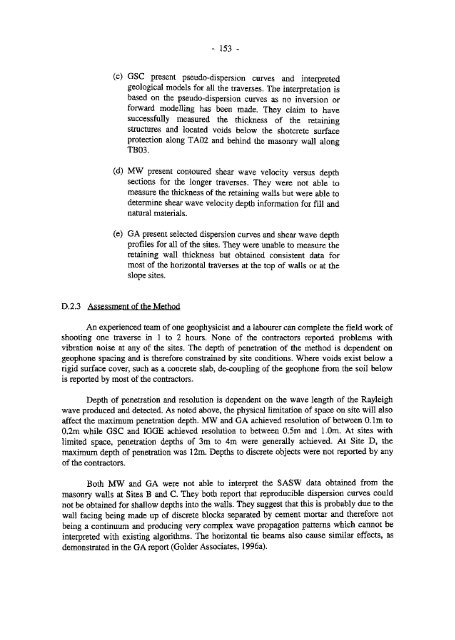site characterisation study - phases 1 and 2 - HKU Libraries - The ...
site characterisation study - phases 1 and 2 - HKU Libraries - The ...
site characterisation study - phases 1 and 2 - HKU Libraries - The ...
- No tags were found...
You also want an ePaper? Increase the reach of your titles
YUMPU automatically turns print PDFs into web optimized ePapers that Google loves.
- 153 -(c) GSC present pseudo-dispersion curves <strong>and</strong> interpretedgeological models for all the traverses. <strong>The</strong> interpretation isbased on the pseudo-dispersion curves as no inversion orforward modelling has been made. <strong>The</strong>y claim to havesuccessfully measured the thickness of the retainingstructures <strong>and</strong> located voids below the shotcrete surfaceprotection along TA02 <strong>and</strong> behind the masonry wall alongTB03.(d) MW present contoured shear wave velocity versus depthsections for the longer traverses. <strong>The</strong>y were not able tomeasure the thickness of the retaining walls but were able todetermine shear wave velocity depth information for fill <strong>and</strong>natural materials.(e) GA present selected dispersion curves <strong>and</strong> shear wave depthprofiles for all of the <strong>site</strong>s. <strong>The</strong>y were unable to measure theretaining wall thickness but obtained consistent data formost of the horizontal traverses at the top of walls or at theslope <strong>site</strong>s.D.2.3 Assessment of the MethodAn experienced team of one geophysicist <strong>and</strong> a labourer can complete the field work ofshooting one traverse in 1 to 2 hours. None of the contractors reported problems withvibration noise at any of the <strong>site</strong>s. <strong>The</strong> depth of penetration of the method is dependent ongeophone spacing <strong>and</strong> is therefore constrained by <strong>site</strong> conditions. Where voids exist below arigid surface cover, such as a concrete slab, de-coupling of the geophone from the soil belowis reported by most of the contractors.Depth of penetration <strong>and</strong> resolution is dependent on the wave length of the Rayleighwave produced <strong>and</strong> detected. As noted above, the physical limitation of space on <strong>site</strong> will alsoaffect the maximum penetration depth. MW <strong>and</strong> GA achieved resolution of between OJm to0.2m while GSC <strong>and</strong> IGGE achieved resolution to between 0.5m <strong>and</strong> 1.0m. At <strong>site</strong>s withlimited space, penetration depths of 3m to 4m were generally achieved. At Site D, themaximum depth of penetration was 12m. Depths to discrete objects were not reported by anyof the contractors.Both MW <strong>and</strong> GA were not able to interpret the SASW data obtained from themasonry walls at Sites B <strong>and</strong> C. <strong>The</strong>y both report that reproducible dispersion curves couldnot be obtained for shallow depths into the walls. <strong>The</strong>y suggest that this is probably due to thewall facing being made up of discrete blocks separated by cement mortar <strong>and</strong> therefore notbeing a continuum <strong>and</strong> producing very complex wave propagation patterns which cannot beinterpreted with existing algorithms. <strong>The</strong> horizontal tie beams also cause similar effects, asdemonstrated in the GA report (Golder Associates, 1996a).
















